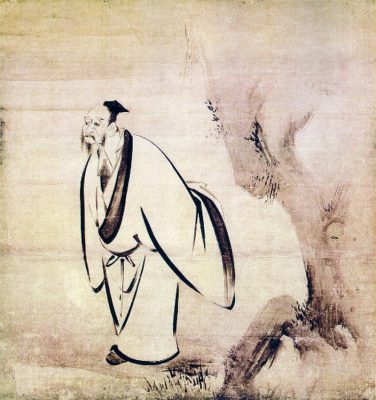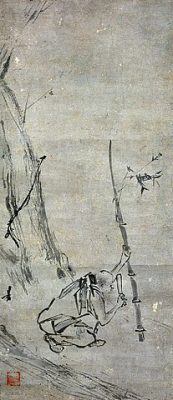Art and Buddhism crossing from the Middle Kingdom to the Land of the Rising Sun
Lee Jay Walker
Modern Tokyo Times

The path of Buddhism in China and Japan knows many roads because of various sects. Equally important, the thought patterns of Buddhism and cultural impact are extremely diverse in China and Japan. This equally applies to regional dynamics in both societies. Therefore, Kaihō Yūshō (1533-1615) and Liang K’ai (1140-1210) epitomize the enormous differences that exist despite the binding force of Buddhism.
In the early development of the artwork of Kaihō Yūshō, it is abundantly clear that he respected Liang K’ai. Monochrome ink paintings by Kaihō Yūshō and a delightful brush stroke that was refined sums up this influence. However, just like the life of Liang K’ai would dramatically alter in later life, the same can be said about the art of Kaihō Yūshō because he would take a different approach to art.

Liang K’ai created stunning art pieces based on Buddhism, Taoism, the spirit world, landscapes, figures, and other areas. Indeed, he was blessed to have studied under Chia Shih-ku.
Interestingly, and hinting at the openness of Zen Buddhism, Liang K’ai went from being an artist who adored alcohol, to a Zen Buddhist monk. It is difficult to imagine such an enormous difference and acceptance from an Abrahamic point of view in this period of history. However, the world of Zen Buddhism and the attributes of being a Zen Buddhist monk aren’t constrained by a morality based on the oneness of God. In other words, a multi-dimensional approach fused with acceptance and understanding enabled a freethinking individual to naturally enter the Buddhist priesthood.

In another article about Kaihō Yūshō, I state, “Ironically, he had been born into a family that was renowned for its military prowess. Yet, the pristine nature of Buddhism in Koyasan, Kyoto, Nara, and other famous parts of Japan, meant that Kyoto impacted greatly on Kaihō Yūshō. Therefore, the Buddhist priesthood appealed naturally to Yūshō once he entered the environs of Kyoto.”
It is difficult to imagine the Christian and Muslim world in this period of history tolerating art depicting a holy person who appears drunk and extremely vulnerable. Indeed, alcohol even today can be punished in Sharia Islamic states. However, for Liang K’ai the different thought patterns of Zen Buddhism entailed that the meaning isn’t what it appears. Equally, a judgmental approach equates to a limited view of the world – and Zen Buddhism, irrespective if part of this world or not belonging to this world, doesn’t seek to be constrained by a straight path equated to the Abrahamic faiths.

Overall, Liang K’ai and Kaihō Yūshō are separated by several centuries and both hail from different cultures. Yet, the ticking clock of Buddhism entailed that some binding facts link both individuals, with the onus being on Kaihō Yūshō searching for inspiration. This notably applies to the early artistic life of Kaihō Yūshō who sought inspiration from Liang K’ai before moving on to his artistic individualism.

Please donate and support the Modern Tokyo Times
Modern Tokyo News is part of the Modern Tokyo Times group
DONATIONS to SUPPORT MODERN TOKYO TIMES – please pay PayPal and DONATE to sawakoart@gmail.com
http://moderntokyotimes.com Modern Tokyo Times – International News and Japan News
http://sawakoart.com – Sawako Utsumi personal website and Modern Tokyo Times artist
https://moderntokyonews.com Modern Tokyo News – Tokyo News and International News
PLEASE JOIN ON TWITTER
https://twitter.com/MTT_News Modern Tokyo Times
PLEASE JOIN ON FACEBOOK